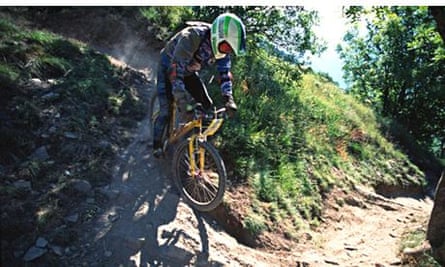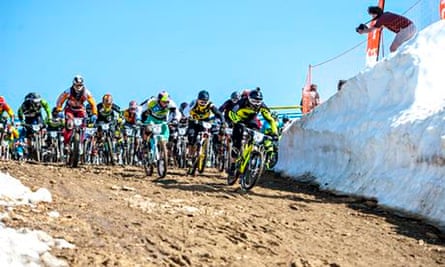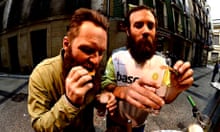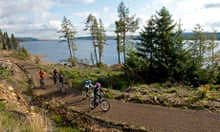The air throbs with the sound of helicopters. Loudspeakers blare out indeterminate beats while hundreds of mountain bikers stand quivering with nervous excitement next to bikes so solid they look like they'd survive a nuclear explosion. The crisp morning sunlight glances off the Sarenne glacier and from where they stand, on the summit of the Pic Blanc, the competitors soak up an epic alpine view. Then an air raid siren blasts out the 10-second countdown, ramping up the atmosphere until the energy of every soul on the mountain explodes as the starting tape is lifted and wheels begin to turn. Amid the chaos, a bemused bloke stands holding his skis mumbles: "Not the best day to decide to ski the glacier."
The place is Alpe d'Huez, and the race is Megavalanche. The first event was held in 1995, the brainchild of downhill mountain bike pioneer George Edwards, who created some of the first dedicated downhill tracks, including Les Gets in France and Fort William in Scotland. His aim was to create a synthesis between the ascents of cross-country and the descents of downhill – a true all-mountain discipline. Around 400 people turned up to race. In 2013, 2,000 riders – professionals and regular Joes (and Joannas) – from 30 countries took on the 30km track with its 2,600m of vertical descent.
In mountain biking, Mega is legend. "The atmosphere is magic," said three-time winner Remy Absalon, "but I look forward to having the start over with: there's all this apprehension and uncertainty, but it is exhilarating – you're riding at 100km an hour on snow surrounded by loads of other people."
Megavalanche is the king of gravity enduro races. A typical enduro race involves a series of stages combining timed downhill sections with untimed uphills. The winner is the one with the fastest time over all the stages combined. Mega is different: it isn't about racing against the clock, but about getting to the finish line first. But it's still the longest timed downhill stage in the world and the only one with a mass start on a glacier, which adds a level of jostling to the proceedings.

For the most part, the first five minutes are spent sliding down at warp speed on your back holding your bike aloft. The route begins at 3,320m and rips its way to the village of Allemont through every type of alpine terrain you can envisage: from snow and lunar-like landscapes to rocky ridgelines with vertiginous drops and forest trails where lattice light plays havoc with your vision. For an average rider it will take over an hour to complete – hence the word enduro, as the stamina required to tackle mountain bike terrain for that length of time definitely requires it.
The event is open to anyone game enough to register – 10 timed qualifying races sift the fastest riders out for the final race. Despite the number of amateurs racing, injuries have so far remained modest. "Most accidents happen in training," said Cathy Labouyrie one of from the organising team. "Mainly it's things such as broken arms. The track is designed to be as safe as possible – putting curves in the high-speed parts [to slow riders down], the glacier spreads people out It's not as dangerous as you imagine."
Such is the scale of Megavalanche that for a week in July the empty resort fills with riders and spectators; people fixing bikes in car parks, knee pads and body armour scattered around; chalets filled with muddy clothes, beers and banter; hibernating bars reopened to lubricate the dry throats of cyclists.
"The beauty of Mega is that it's accessible to most riders, in that you don't need a specific bike like you do for downhill or cross-country," said Fionn Griffiths, former World Cup downhill champion.
Absalon echoes that: "Enduro is not just hardcore: it's more fun. For me, it's everything I look for in mountain biking in one discipline."
What it feels like: Tom Humpage, 32, photographer

The first time I rode the Mega I had no idea what to expect. Everyone says it's the one race all mountain bikers should try – the terrain is more aggressive than the UK, the danger level is higher, and with all the helicopters, noise and photographers there's a certain glamour to it. Plus, it starts on the glacier, which is daunting and not something you often ride. As it gets slushier you lose control of your front wheel and you end up with your feet off the pedals acting as stabilisers.
I can carry my speed into pretty much anything but on that glacier I always feel like I'm going to fall off. By the time you come into the first bit of single track, which curves through this spectacular barren landscape, you can get into your stride and hopefully you won't get stuck behind anyone.
It is technical: anyone could ride it but the less experienced would have to walk in parts; and it's not for the fainthearted as the drops can be steep. It takes in every type of terrain but at no point are you paying attention to the scenery – that's for the lifts uphill throughout the week you're there. Mainly you're pedalling, sweating, and trying not to hit the deck or skid down a 40-degree scree slope.







Comments (…)
Sign in or create your Guardian account to join the discussion